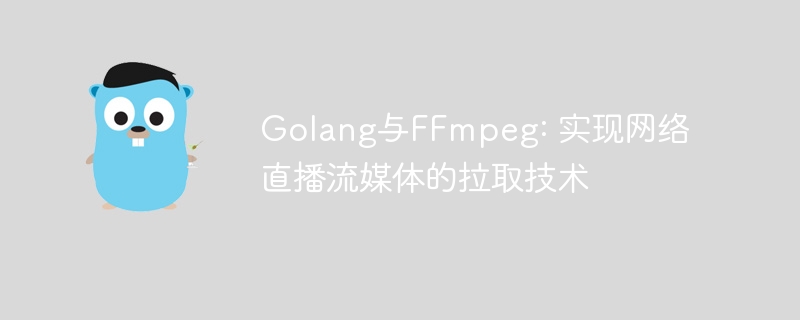Home >Backend Development >Golang >Golang and FFmpeg: Pulling technology for online live streaming media
Golang and FFmpeg: Pulling technology for online live streaming media
- WBOYWBOYWBOYWBOYWBOYWBOYWBOYWBOYWBOYWBOYWBOYWBOYWBOriginal
- 2023-09-28 16:09:45858browse

Golang and FFmpeg: Implementing the pulling technology of online live streaming media requires specific code examples
Introduction:
Now, with the popularity of the Internet, live broadcasting The industry is gradually taking over people's daily lives. The pulling technology to realize online live streaming is an important part of this industry. This article will use Golang and FFmpeg as the main tools to introduce how to use these two tools to pull online live streaming media, and give specific code examples.
1. What is Golang?
Golang (also known as Go) is an open source programming language developed by Google. It has the characteristics of simplicity, efficiency, reliability, etc., and has gradually become popular and is widely used in fields such as network services, cloud computing, and data analysis. Golang's high concurrency capabilities and rich standard library make it a good choice for implementing pull technology for online live streaming media.
2. What is FFmpeg?
FFmpeg is a cross-platform open source multimedia processing tool that can record, transcode, and merge audio and video. FFmpeg supports a variety of common audio and video formats and has good performance and stability. In the pull technology to implement network live streaming media, FFmpeg can be used to obtain the live stream from the network and transcode it to other formats or save it to a file.
3. Use Golang and FFmpeg to pull online live streaming media
The following are the specific steps to use Golang and FFmpeg to pull online live streaming media:
- Download and install FFmpeg
First, you need to download and install FFmpeg. You can find the corresponding installation package on the FFmpeg official website (https://ffmpeg.org/), and follow the official guidance to complete the installation process. - Golang code implementation
Next, write code in Golang to call the FFmpeg command line tool. The following is a sample code:
package main
import (
"fmt"
"os/exec"
)
func main() {
cmd := exec.Command("ffmpeg", "-i", "http://example.com/live/stream.m3u8", "-c", "copy", "output.mp4")
err := cmd.Run()
if err != nil {
fmt.Println("Error:", err)
return
}
fmt.Println("Finished")
}The above code uses Golang's os/exec package to perform command line operations. By calling the exec.Command function and passing in the corresponding parameters, you can call FFmpeg to pull the network live stream. In the above example, we change the URL after the -i option to the actual webcast stream address, and change output.mp4 to the desired saved file name. Achieve pulling from online live streams and saving them locally.
- Run and test
Finally, compile and run the above Golang code. As you can see, the code will execute a system command line and call FFmpeg to pull the network live stream and save it locally.
Summary:
This article introduces how to use Golang and FFmpeg to implement the pulling technology of online live streaming media, and gives specific code examples. By using Golang's high concurrency capabilities and rich standard libraries, as well as FFmpeg's powerful audio and video processing capabilities, you can easily pull and process audio and video data from online live streams. This is very helpful for developing live broadcast systems or implementing video recording functions. I hope this article will help you understand the use of Golang and FFmpeg as well as the pulling technology for online live streaming.
The above is the detailed content of Golang and FFmpeg: Pulling technology for online live streaming media. For more information, please follow other related articles on the PHP Chinese website!

